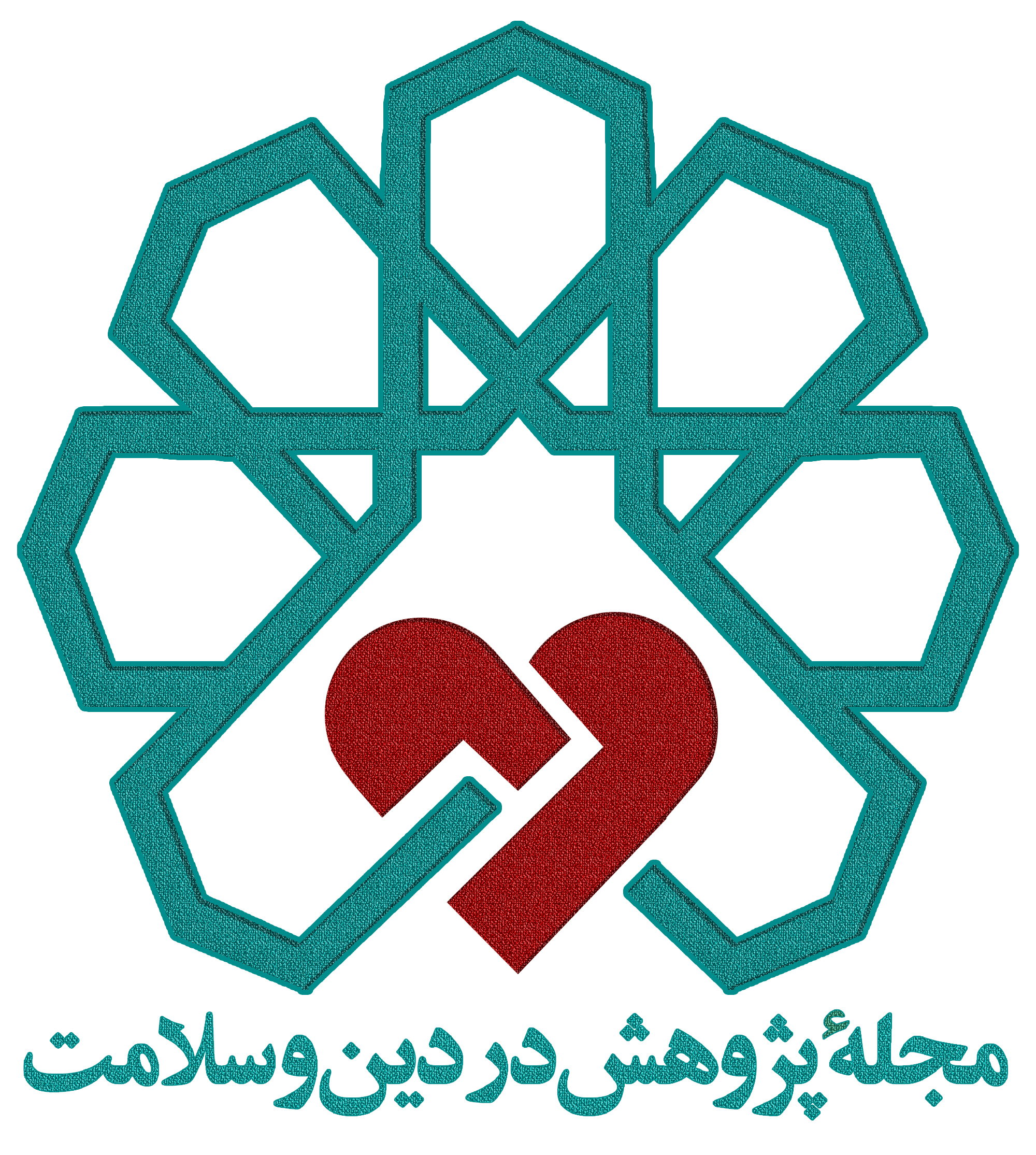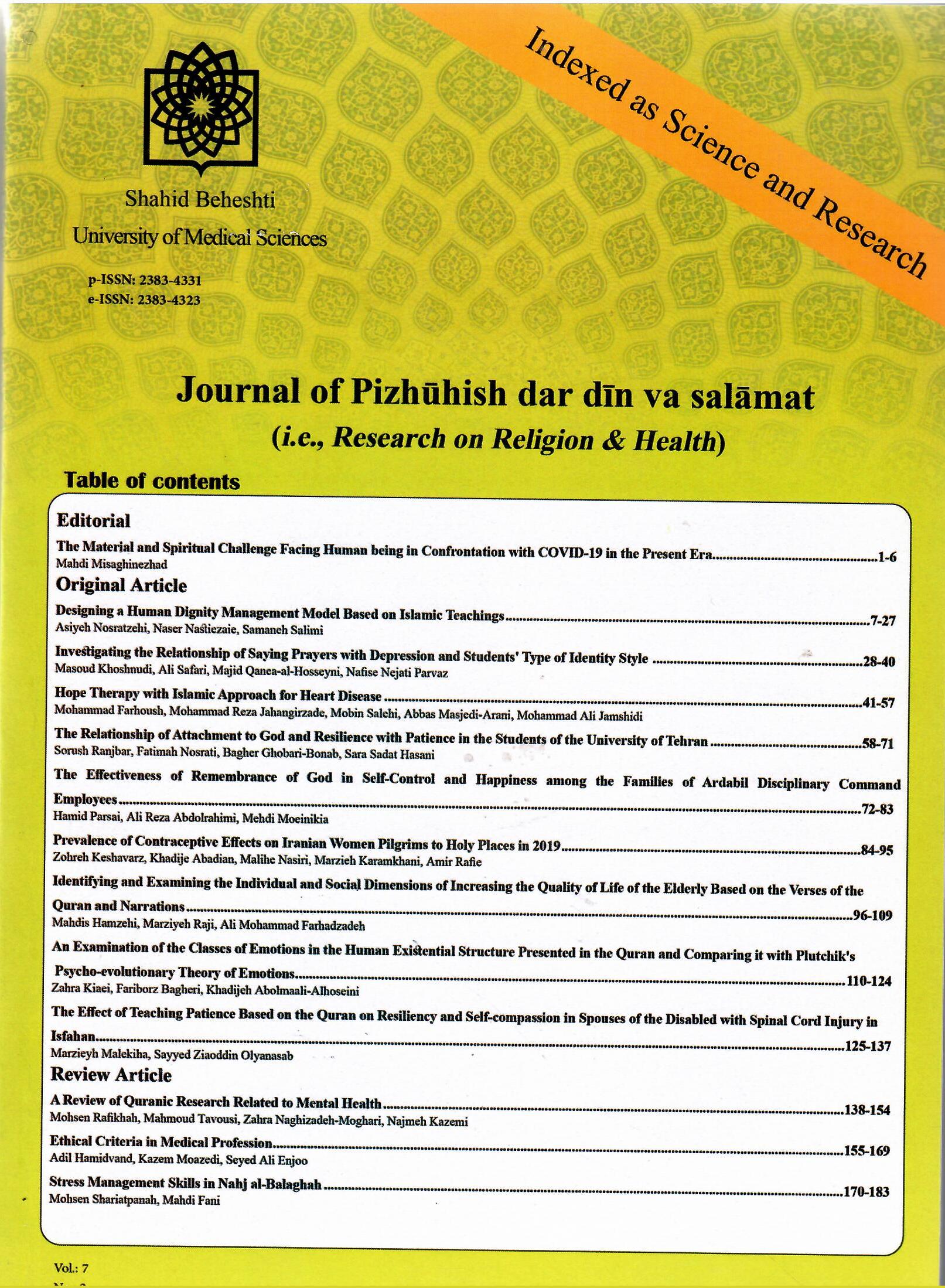بررسی طبقات هیجان در ساختار وجودی انسان در قرآن منطبق بر نظریۀ روانتکاملی پلاتچیک
پژوهش در دین و سلامت ,
دوره 7 شماره 2 (2021),
21 June 2021
,
صفحه 110-124
https://doi.org/10.22037/jrrh.v7i2.29484
چکیده
سابقه و هدف: انسان نوین بیش از هر زمان دیگر انسانی هیجانی است و خروج هیجانات از حالت طبیعی، درحالیکه عامل بقای نوع و فرد انسان معرفی میشود، سبب طیف گستردهای از بیماریهای روانی میشود که بر اساس پژوهشها رو به گسترش است. تعاریف و طبقات متعددی در نظریات مختلف برای هیجانات و روابط بین آنها ذکر شده که بسیاری از آنها ضمن مطالعۀ رفتار حیوانات و تطبیق آن با انسان به دست آمده است. نظریۀ روانتکاملی هیجانات پلاتچیک از مهمترین و کارآمدترین آنها است؛ اما آیا این همه طبقات هیجانی انسانها است؟ مبتنی بر آموزههای اسلامی و قرآنی انسان موجودی فراتر از حیوان و دارای بُعدی روحانی است؛ پس هیجانات متفاوتی را میتوان برای او تصور کرد. به همین منظور هدف پژوهش حاضر تطبیق طبقات هیجانی پلاتچیک با ساختار وجودی انسان در قرآن بود.
روش کار: در پژوهش حاضر به روش تحلیل محتوا نخست فرم کدگذاری ارزیابی از طبقات هیجانات پلاتچیک و تصویر انسان در قرآن با استفاده از کتب و منابع پلاتچیک و قرآن و تفسیر تهیه شد و در اختیار دو ارزیاب آموزشدیده قرار گرفت. در این پژوهش همۀ موارد اخلاقی رعایت شده است و مؤلفان مقاله تضاد منافعی گزارش نکردهاند.
یافتهها: نتایج بهدستآمده نشان داد که همۀ طبقات هیجانی پلاتچیک در ساختار انسان قرآنی و بیشتر در دو بخش «حالت» و «قوت» وجود دارد و مبتنی بر آن 26 طبقۀ هیجانی جدید چون ضیق، فرح، رعب، ربط و اعمی و 20 ترکیب هیجانی دیگر پیشنهاد شد.
نتیجهگیری: نتایج ضمن معرفی هیجاناتی جدید که با درنظرگرفتن ابعاد مادی و غیرمادی وجود انسان ارائه میشود؛ جایگاه هیجانات را بر اساس ساختار وجودی انسان در قرآن «قلب» معرفی میکند و طبعاً قلب است که بیماریاش سرمنشأ اختلالات هیجانی و سلامتش متضمن درمان معرفی میشود.
استناد مقاله به این صورت است:
Kiaei Z, Bagheri F, Abolmaali-Alhoseini Kh. An Examination of the Classes of Emotions in the Human Existential Structure Presented in the Quran and Comparing it with Plutchik's Psycho-evolutionary Theory of Emotions. Journal of Pizhūhish dar dīn va salāmat. 2021;7(2):110-124. https://doi.org/10.22037/jrrh.v7i2.29484
- اسلام، انسانشناسی، اختلالات روانی، بیماریهای قلبی، صدر، قلب، هیجانات
ارجاع به مقاله
مراجع
Plutchik R. A Psychoevolutionary Synthesis. New York: Harper & Row; 1980.p.162.
Reeve J. Motivation and Emotion. Translated by Yahya Seyed Mohammadi 7 ed. Tehran: Virayesh; 2019. (Full Text in Persian)
Plutchik R. Emotion in the practice of psychotherapy. Washington, DC: American Psychological Association;2000.
Kiaei Z, Bagheri F, Abolmaali K. Comparison of human image from platchik and Schwartz with man map in the Quran through content analysis. Tehran: science and research university; 2020. (Full Text in Persian)
Watson D, Naragon-Gainey K. Personality, emotions, and the emotional disorders. Clinical Psychological Science. 2014;2(4):422-42.
Plutchik R, Kellerman H. Emotion (Theory, Research and Experience). New York: Academic press; 1980.
Vandenbos GR. APA Dictionary of psychology. 2 ed. Washington, DC; 2007.
Watson R. Future Files A Brief History of the Next 50 Years. London: Nicholas, Brealey; 2010.
Starks M. Suicidal Utopian Delusions in the 21st Century: Philosophy, Human Nature and the Collapse of Civilization. 4 ed. New York: Independently published; 2018.
Yuta Bann E. Discovering B asic Emotion Sets via Semantic Clustering on a Twitter Corpus: University of Bath BSc (Hons) Computer Science Dissertation; 2012.
Ortony A, Turner TJ. What's basic about basic emotions? Psychological Review;1990.p.315-31.
Plutchik R. The Nature of Emotions: Human emotions have deep evolutionary roots, a fact that may explain their complexity and provide tools for clinical practice Journal American Scientist. 2001;89(4):344-50.
Plutchik RC, Hope R Circumplex models of personality and emotions. Washington DC: American psychological association; 1997.
LeDoux JE. Evolution of human emotion: a view through fear Progress in brain research Elsevier; 2012.
Phelps EA, LeDoux JE. Contributions of the amygdala to emotion processing: from animal models to human behavior. Neuron. 2005;48(2):175-87.
Phelps EA. Human emotion and memory: interactions of the amygdala and hippocampal complex. Current opinion in neurobiology. 2004;14(2):198-202.
Mehrabi Bahar A. National Doctrine of the Health of the Islamic Republic of Iran on Horizon 1414 (Dissertation). Tehran: University of Tehran; 2010. (Full Text in Persian)
Mirzaei R, Khosrowpanah A. The quiddity of anthropology. Religious Anthroplogy. 2011;7(24):35-63. (Full Text in Persian)
Jafari MT. The Quran, the symbol of reasonable life. 1 ed. Tehran: Allameh Jafari Institute for Compilation and Publication; 2002. (Full Text in Persian)
Bahmani F. Relation of the heart in Persian literature with Sadr, Shafaq, Heart and Fadd in the
Holy Quran. 2 ed. Tehran: Thought School; 2012. (Full Text in Persian)
Khanbabaei M, Fayyaz ID, Malaki H. The Explanation of Educational Model of Educated Man based on Human Map in the Quran. Tehran: Allameh Tabataba'i; 2019. (Full Text in Persian)
Tabataba'i F, Bagheri F. Studying Sexual Fantasies in Emotional Relations based on Grounded Theory. Tehran: Science and Research; 2018. (Full Text in Persian)
Ghorashi A. Quran Qamoos. Tehran: Darolketab al-Islami; 2003. (Full Text in Persian)
Bagheri F. Naghsh-e Mafhoom-e Ghayat-Shenakhti dar Taeen-e Nahanjare-haye Marefat-Shenasi ba Roykard-e Materyalism. Zehn. 2012;13(50):50-85. (Full Text in Persian)
The holy Quran. Al-Hojorat. Verse 7. Translated by: Mohammad Mahdi Fouladvand. Tehran: Justice Message Publications; 2016.
The holy Quran. Al-Bagharah. Verse 256. Translated by: Mohammad Mahdi Fouladvand. Tehran: Justice Message Publications; 2016.
Vejdani F, Imani M. Tahlil-e Mafhoom-e Roshd ba Teky-e bar Ayat-e Ghoran-e Karim. Research in Islamic Education Issues. 2013.20(16):11-35. (Full Text in Persian)
The holy Quran. Al-Bagharah. Verse 7. Translated by: Mohammad Mahdi Fouladvand. Tehran: Justice Message Publications; 2016.
The holy Quran. Al- An'am. Verse 125. Translated by: Mohammad Mahdi Fouladvand. Tehran: Justice Message Publications; 2016.
The holy Quran. Al-Yusuf. Verse 30. Translated by: Mohammad Mahdi Fouladvand. Tehran: Justice Message Publications; 2016.
Abolmaali K. Deduction/Induction: Qualitative Text Analysis. Educational Science from Islamic Point of View.2013;1(1):85-102. (Full Text in Persian)
Javadi Amoli A. Tasneem Tafsir. 50 ed. Qom: Esrae; 2016. (Full Text in Persian)
Tabataba'i SMH. Tafsir al-Mizan. Qom: Islamic Publications Office; 1971. (Full Text in Persian)
Bagherian Khuzani M. The nature of heart disease and its treatment in Quran and Narrations. Ma'rifat. 2019;27(4):35-48. (Full Text in Persian)
Kaviani M, Panahi A. Psychology in the Quran: Your Concepts and Teachings. 6 ed. Qom: Research Institute of Hawzah and University; 2016.p.316. (Full Text in Persian)
Qureishi AA. The meaning of the Quran. 9 ed. Qom: Dar al-Ketab al-Islamiyah. 2002. (Full Text in Persian)
Bahrami Ehsan H, Amjadian M, Rostami R, Vahedi S. Designing a Religous-based Intervention Theory Based on Islamic Teachings for Anxiety, Stress, and Depression Reduction in Coronary Artery Bypass Grafting Patients. Journal of Religion and Health. 2019;6(2):40-52. (Full Text in Persian)
Sanatnegar S, Bahrami H, Okhovat A, JanBozorgi M. The Semantics of Generalized Anxiety Disorder from the View of the Holy Quran. Studies in Islam and Psychology. 2017;11(20):89-115. (Full Text in Persian)
Willcox G. The Feeling Wheel A Tool for Expanding Awareness ofEmotions and Increasing Spontaneity and Intimacy. Transactional Analysis Journal. 2001;12(4).
Milani M. Human-animal emotional contagion and client communication. The Canadian Veterinary Journal. 2017;58(12):1329. (Full Text in Persian)
Sotres-Bayon F, Quirk GJ. Prefrontal control of fear: more than just extinction. Current opinion in neurobiology. 2010;20(2):231-5.
Atkinson RL, Atkinson RC, Smith EE, Bem DJ, Nolen-Hoeksema S. Atkinson and Hilgard's Introduction to Psychology (with Lecture Notes and InfoTrac). Tehran: Roshd; 2017. (Full Text in Persian)
Minsky M. The Emotion Machine. New York: Simon & Schuster; 2007.
Glasser W. Choice Theory: A New Psychology of Personal Freedom. New York: HarperCollins Publishers Inc; 2005.
- چکیده مشاهده شده: 253 بار

